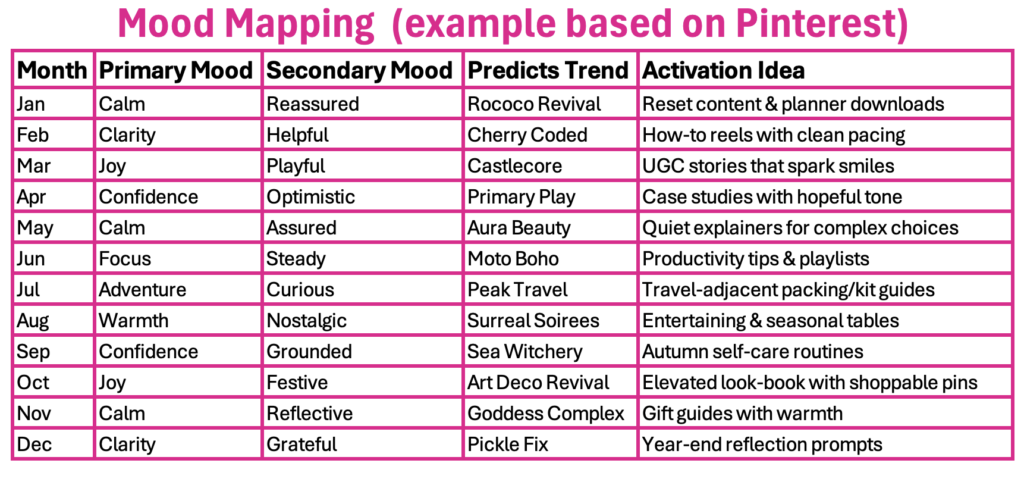September 17, 2025
Social is increasingly about how content feels to the person on the other end (AKA Mood-based marketing). When you show up with a steady atmosphere (calm, confidence, small sparks of joy) people stick around and come back. And you can measure it properly: saves, meaningful comments, watch-time through key beats, and a nudge in branded search.
The trust engine is emotional, not performative
Edelman’s 2025 Brand Trust special report is plain: people want brands to help them feel happy, confident, inspired, safe and calm. In other words, stability first. If your content leaves them a little more settled or hopeful, trust follows. Build for those feelings and you’re working with the grain of consumer expectations. edelman.com
It’s worth trying out mood-based marketing if you can. Choose two emotions to hold for the quarter and tune tone, pacing, sound and replies to match. Log any lift in saves and branded search against those mood cues.
Did you know that trust in the new KPI? So definitely worth focusing on feelings if you want to focus on driving growth.
Culture-tuning beats trend-hopping
Teams are using social listening to read culture, not just keywords. Hootsuite’s 2025 research shows about a third of brands use listening to stay current, and 31% of social listeners say analysing cultural trends is now a primary objective. That’s your permission to pick fewer, better moments that suit your brand’s atmosphere. Hootsuite

I’d recommend that you track aesthetics, rituals and communities alongside sentiment.
Authentic beats glossy, and usually costs less
User-generated creative keeps punching above its weight. UGC ads delivering around 4x higher CTR and roughly 50% lower CPC than polished brand ads. Pair that with long-standing evidence that shoppers see UGC as more authentic than brand content and you’ve got a pragmatic way to lift performance while easing budgets. Results vary by category, but the direction of travel is clear. Amra and Elma

The creator market isn’t fading. Influencer Marketing Hub estimates the industry at about $32.55bn in 2025, with marketers continuing to rate creator activity as effective.
Big networks are doubling down too, which tells you where budgets are heading. Treat creators as mood carriers for your brand, not just a one-off post.
Platforms are quietly optimising for mood-based marketing
YouTube
Google is literally placing ads after “peak” emotional moments. Peak Points uses Gemini to find the most engaging beats in a video and drop your ad right after. Build creative to land on a feeling viewers already have. TechCrunch
Pinterest
Pinterest Predicts remains a goldmine for upcoming aesthetics. Plan content around rising “vibes” months ahead, then merchandise those boards. Pinterest
TikTok
TikTok’s Symphony suite speeds up creative testing with text-to-video, image-to-video and avatars. Use it to spin mood-matched variants quickly, but keep a human on brand guard.
The consumer shift that makes this work
- Social and creators are now central to entertainment time, pulling both attention and ad money into social video. Deloitte
- Social commerce is normal: 61% discovered a new brand on social in the last year; 71% rate their last social purchase as good or excellent. Deloitte Digital
- In the UK, adults now spend more time on mobiles than on linear TV. If your mood lands on mobile, you win the day. The Guardian
- Gen Z keeps voting for authenticity and meaningful engagement in public. That’s vibe territory.
How to make mood-based marketing work
- Define your brand’s mood board
Pick 2–3 durable feelings you want your audience to have with you. Example: “calm clarity”, “optimistic progress”, “spirited joy”. Write rules for tone, colour, sound, pace and community behaviour. - Build a culture radar
- Set up listening queries for aesthetics, sounds, micro-communities and rituals, not just keywords and sentiment.
- Track cultural trendlines monthly. Only jump when the mood fits your board.
- Architect your content to moods, not formats
- Short-form when the moment needs pace; long-form when trust needs depth.
- Always pair UGC-style assets with your brand version to lower CPC and prove lift.

- Wire measurement to feelings
Move beyond vanity. Score: saves, replies, comment quality, watch retention at “peak” beats, branded search lift, and assisted revenue. Use holdouts to show incremental impact. - Mood-native media buying
- YouTube: test Peak Points; write the first 3 seconds of your ad to “catch the exhale” immediately after the peak. TechCrunch
- Pinterest: ship shoppable boards around Predicts trends that match your brand atmosphere; refresh seasonally. Pinterest
- TikTok: use Symphony to generate 5–10 vibe variants, then force-rank by retention and comments that mirror your target feeling. Newsroom | TikTok
Watch out! Where brands go wrong
- A pretty aesthetic with no product truth. Consumers can smell it. Edelman’s 2025 read is plain: people want practical reassurance, not posturing. Also known as vibe-washing
- Symphony can scale tests, but it can also flatten voice. Keep a strong brand editor in the loop. Marketing Dive
- If every week is a different mood, you’re training the audience not to know you. Listening is there to say “not this one”.
Mood-based marketing isn’t soft. It’s disciplined. You’re engineering consistent emotional states that people trust, then letting formats and media do their job. The upside: lower paid costs via UGC, better retention at peak moments, stronger brand search, and social commerce that feels inevitable rather than pushy. That’s how you move from viral spikes to compounding brand equity.
